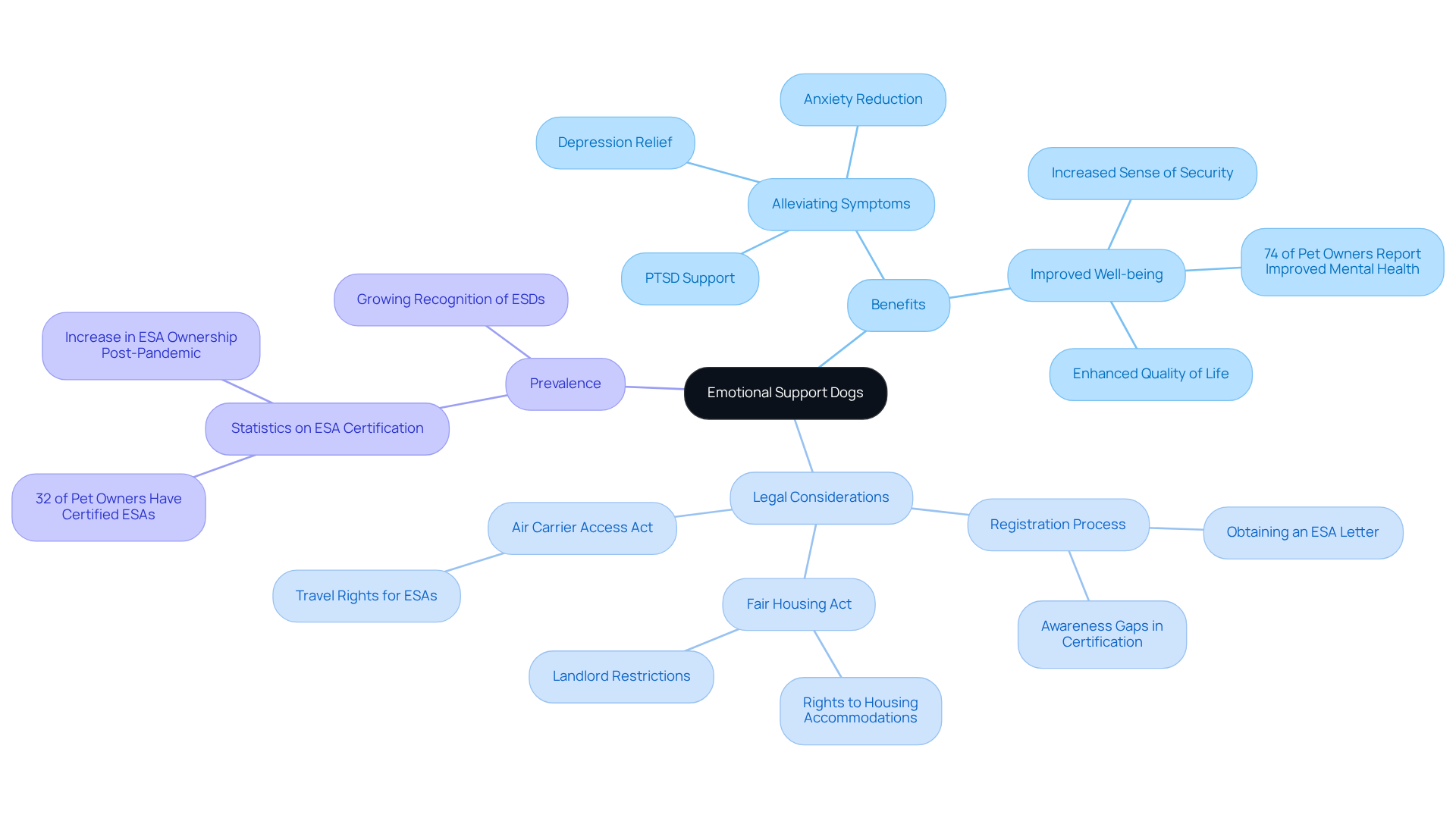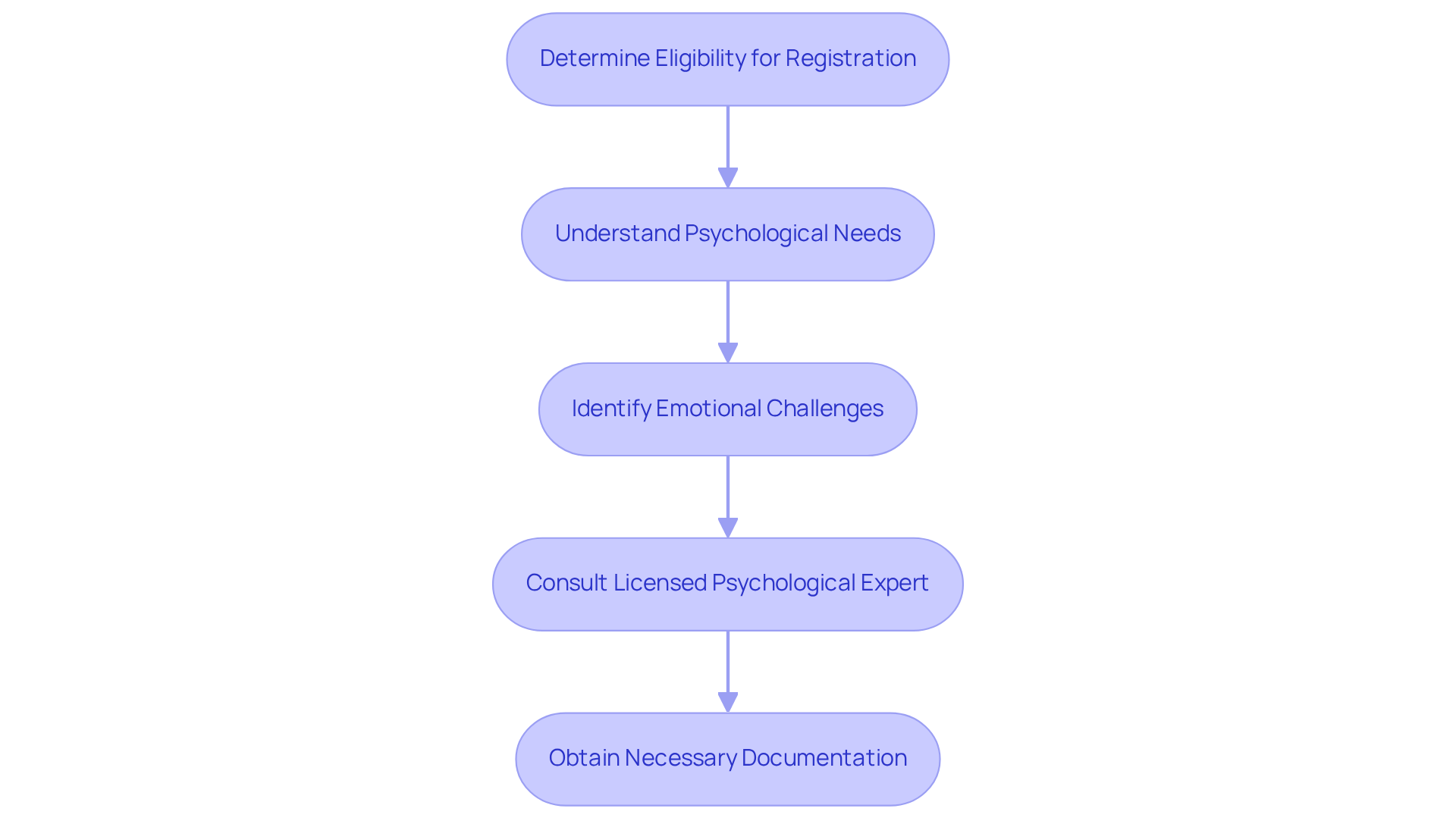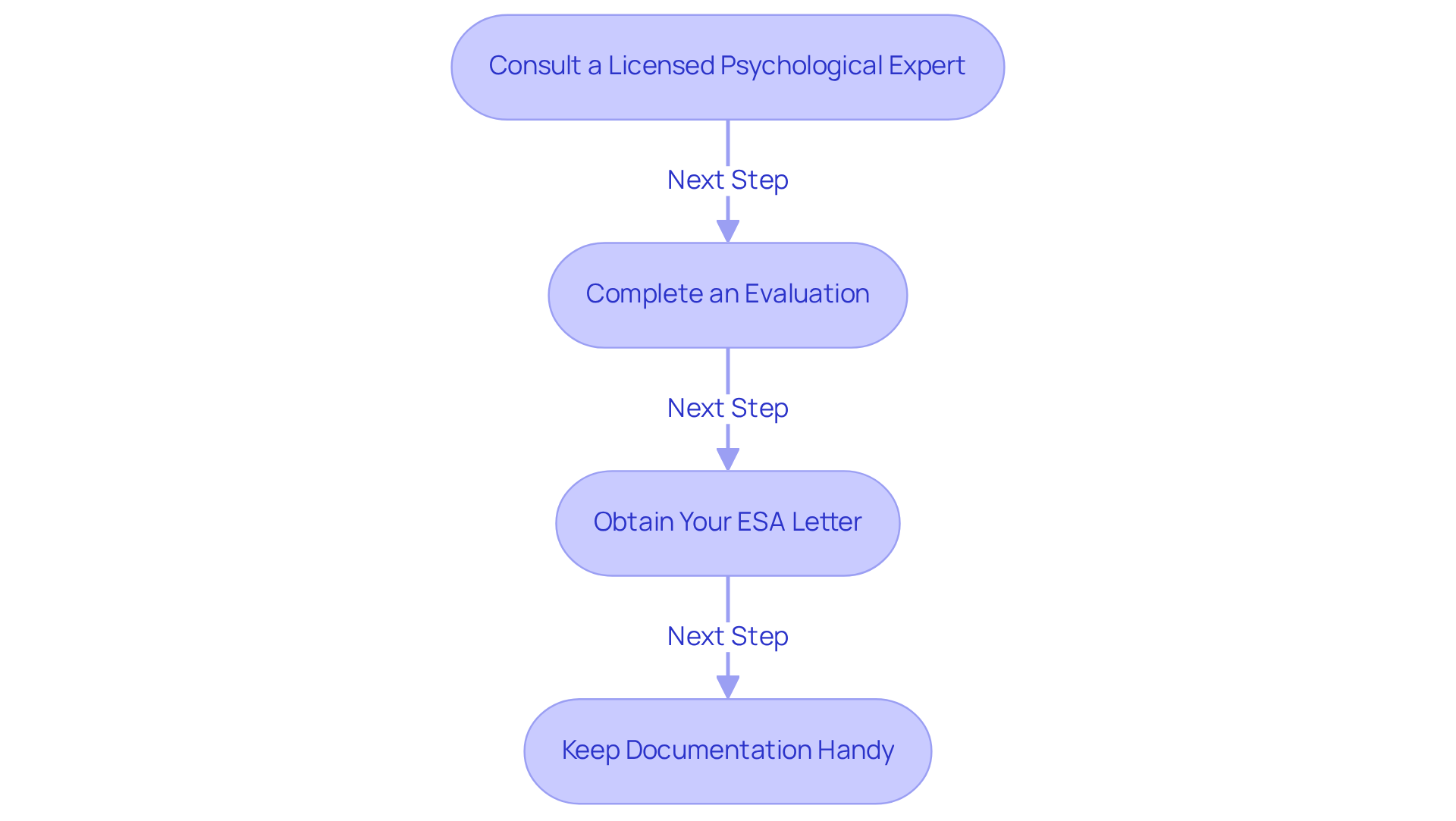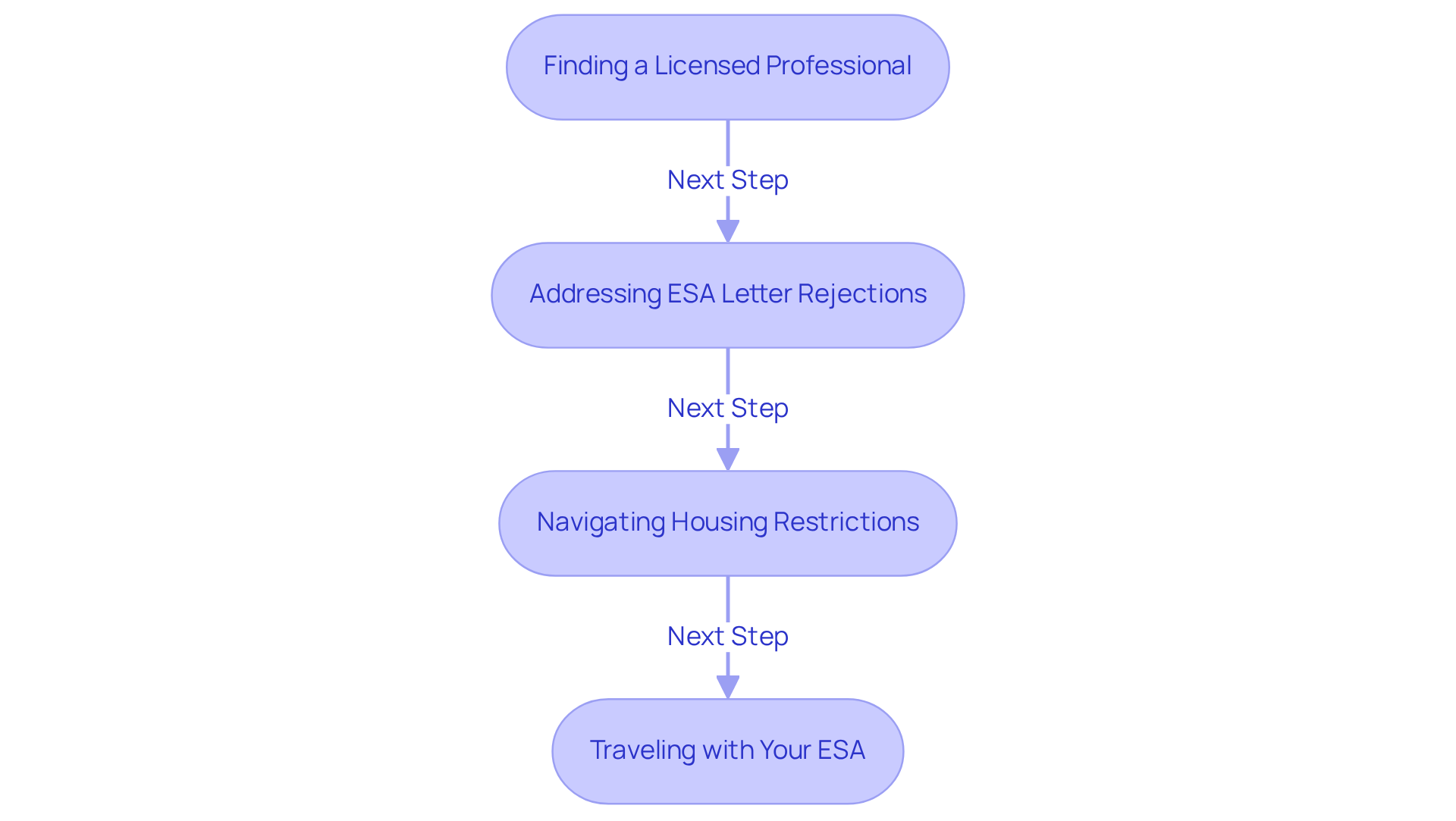

How to Register an Emotional Support Dog: A Step-by-Step Guide
by Lena Park
Last updated: August 25, 2025
Verified and Approved by:
Angela Morris,
MSW, LCSW
Fact Checked

Overview
Navigating mental health challenges can be overwhelming, and for many, the journey is filled with emotional struggles. To find solace, individuals may consider registering an emotional support dog. The first step in this compassionate process involves consulting with a licensed psychological expert who can assess their mental health needs. This professional guidance is crucial in obtaining an official ESA letter, which documents the necessity of having a support animal in their lives.
Having an emotional support animal can significantly enhance one’s quality of life, providing comfort and companionship during difficult times. The importance of proper documentation cannot be overstated, as it opens doors to essential housing and travel accommodations. Legal rights under the Fair Housing Act and the Air Carrier Access Act further reinforce the support available to those in need, ensuring that they can access the resources necessary for their well-being.
In this structured process, it’s vital to remember that you are not alone. Many individuals have found hope and healing through the companionship of an emotional support dog. Embracing this journey can lead to a more fulfilling life, filled with the love and support that only a furry friend can provide. As you consider this path, know that there are compassionate solutions available to help you navigate your emotional landscape.
Introduction
Navigating the complexities of mental health can often feel overwhelming. For many, the companionship of an emotional support dog (ESD) serves as a beacon of hope. These remarkable animals play a crucial role in providing comfort and stability, especially for individuals grappling with anxiety, depression, or PTSD.
Understanding how to register an emotional support dog is essential, as it unlocks the rights and benefits that come with this invaluable relationship.
What challenges might arise in the registration process? How can individuals ensure they secure the support they need? These questions are important as they reflect the emotional journey many face, and finding the answers can lead to a more supportive path forward.
Understand Emotional Support Dogs and Their Role
Support animals (ESDs) serve as vital companions for individuals navigating the complexities of psychological or mental challenges. While service dogs are trained to perform specific tasks for those with disabilities, ESDs primarily provide comfort and psychological stability. Their presence is instrumental in alleviating symptoms associated with anxiety, depression, PTSD, and other psychological conditions. In fact, research reveals that 74% of pet owners experience enhanced well-being after welcoming a pet into their lives, underscoring the profound impact of animal companionship on personal satisfaction.
Understanding how to register an emotional support dog is essential for those considering the role of a support dog. Proper documentation is crucial for accessing housing and travel accommodations under the Fair Housing Act and the Air Carrier Access Act. This legal recognition empowers individuals to advocate for their rights, especially in environments where pets are typically restricted. Unlike service dogs, ESDs do not possess the same legal rights and access to public spaces, which is a significant factor for prospective ESA owners. Moreover, the unique bond between an individual and their ESD deepens the therapeutic benefits of animal companionship, illustrating how to register an emotional support dog as a meaningful step toward enhanced mental health.
The prevalence of support animals in the U.S. is on the rise, with 32% of pet owners having their pets certified as ESAs. This growing trend reflects an increasing recognition of the support that animals provide, particularly during challenging times. Mental wellness experts emphasize that the presence of an ESD can significantly reduce anxiety and improve overall mood, making them an invaluable resource for those in need.
Have you ever considered how the companionship of an ESD could transform your well-being? The journey toward mental wellness is deeply personal, and having the support of an emotional support animal can be a comforting and empowering experience.

Determine Eligibility for Registration
Establishing eligibility for registering an emotional support dog begins with a deep understanding of your psychological needs. Many individuals face emotional challenges, such as:
- Anxiety disorders
- Major depressive disorder
- Post-traumatic stress disorder (PTSD)
It’s important to recognize that approximately 26% of adults in the U.S. experience a diagnosable psychological illness each year, underscoring the widespread nature of these conditions.
Consulting with a licensed psychological expert is a vital step in this journey. They can thoughtfully assess your psychological history, current symptoms, and the potential benefits of having a support dog. This process often requires multiple sessions to ensure a thorough understanding of your unique situation. As one specialist insightfully notes, ‘A certified practitioner can examine your current psychological state and determine how an ESA could integrate into your treatment strategy.’
If you feel that you meet the criteria, the next step is to understand how to register an emotional support dog by obtaining the necessary documentation. This formal recommendation is essential for understanding how to register an emotional support dog and ensuring that you receive the assistance you truly deserve. Remember, you are not alone in this journey, and support is available to help you navigate these emotional challenges.

Follow the Steps to Obtain an ESA Letter
Obtaining an ESA letter can be a vital step in addressing your emotional needs. Here’s a gentle guide to help you through the process:
-
Consult a Licensed Psychological Expert: Begin by arranging a meeting with a counselor or psychiatrist who understands your unique psychological needs. It’s important to share your symptoms and discuss how to register a emotional support dog that could enhance your well-being. Remember, the focus of this assessment is to identify any psychological or cognitive impairments and understand how they affect your daily life.
-
Complete an Evaluation: During your consultation, the psychological expert will conduct an evaluation to determine your eligibility for an ESA. This may involve answering questionnaires or engaging in conversations about your psychological challenges. Reflecting on your experiences can be a powerful part of this process.
-
Obtain Your ESA Letter: If you qualify, the psychological expert will provide you with an official ESA letter. This important document should include key details such as the clinician’s name, license type, license number, contact information, and a statement affirming your need for a support dog to understand how to register a emotional support dog. It’s essential that the letter is printed on official letterhead to confirm its authenticity. With Wellness Wag, you can expect to receive your professionally crafted ESA letter with legal recognition within 24 hours of your consultation.
-
Keep Documentation Handy: Safeguard your ESA letter, as you may need to present it when applying for housing or traveling with your dog. It’s crucial to keep this letter updated annually, as ESA letters typically remain valid for one year from the date of issue. Many individuals have shared how having a valid ESA letter has significantly eased their housing challenges and travel experiences. Additionally, remember to inform your landlord and airlines about your ESA to ensure that you comply with their policies.
Your journey towards emotional support is important, and knowing that help is available can make a world of difference.

Troubleshoot Common Registration Issues
Registering an emotional support dog can be a challenging journey, filled with emotional ups and downs. You may feel overwhelmed, but know that you are not alone. Here are some compassionate tips to help you navigate these hurdles:
-
Finding a Licensed Professional can be daunting. If you’re struggling to identify a psychological expert knowledgeable about ESAs, consider utilizing online directories or seeking referrals from friends or support groups. Many professionals are now integrating ESAs into their treatment plans, reflecting a growing recognition of their therapeutic benefits. It’s important to find someone who understands your unique needs.
-
Addressing ESA Letter Rejections can be disheartening. If your ESA letter is rejected by a landlord or airline, take a moment to verify that it complies with all legal requirements. Ensure the letter contains the mental health professional’s license number and contact information. If needed, don’t hesitate to request a revised letter that meets these standards. Remember, your rights matter.
-
Navigating Housing Restrictions can feel isolating. Familiarize yourself with the Fair Housing Act (FHA), which protects your right to possess a support animal, regardless of pet limitations. Present your ESA letter to your landlord and engage in a conversation about your rights under this federal law. It’s crucial to know that discrimination against assistance animals is prohibited, and you deserve to be heard.
-
Traveling with Your ESA can bring its own set of concerns. When preparing for travel, examine the specific policies of the airline regarding support animals. Requirements can vary significantly between airlines, so being well-informed and prepared with the necessary documentation is essential to avoid complications during your journey. Your comfort and peace of mind are paramount.
Understanding these common challenges and knowing how to register an emotional support dog can significantly enhance your experience. Remember, you are taking a positive step towards emotional well-being, and support is available to guide you along the way.

Conclusion
Understanding how to register an emotional support dog is a crucial step for individuals seeking the comfort and companionship these animals provide. Emotional Support Dogs (ESDs) play an essential role in enhancing mental well-being, offering support to those grappling with anxiety, depression, PTSD, and other psychological challenges. By navigating the registration process, individuals can secure the necessary legal recognition to access housing and travel accommodations, thereby empowering their journey towards mental health.
Throughout this guide, we have highlighted key points, including:
- The importance of consulting a licensed psychological expert to determine eligibility
- The steps to obtain an official ESA letter
- Common challenges faced during the registration process
Each step is designed to facilitate a smoother experience, from understanding personal psychological needs to effectively addressing any issues that may arise with landlords or airlines.
Ultimately, the journey to registering an emotional support dog transcends mere paperwork; it embodies a commitment to improving one’s mental health. By taking these steps, individuals can unlock the myriad benefits of having an ESD, fostering a deeper bond that enhances emotional well-being. Embracing the support of an emotional support animal can be transformative, and it is essential to advocate for one’s rights and seek the companionship that can lead to a more fulfilling life.
Frequently Asked Questions
What is the primary role of emotional support dogs (ESDs)?
Emotional support dogs primarily provide comfort and psychological stability to individuals facing psychological or mental challenges, helping to alleviate symptoms associated with anxiety, depression, PTSD, and other conditions.
How do emotional support dogs differ from service dogs?
Unlike service dogs, which are trained to perform specific tasks for individuals with disabilities, emotional support dogs are not trained for specific tasks and do not have the same legal rights and access to public spaces.
What is the significance of registering an emotional support dog?
Proper registration of an emotional support dog is essential for accessing housing and travel accommodations under the Fair Housing Act and the Air Carrier Access Act, allowing individuals to advocate for their rights in environments where pets are typically restricted.
What percentage of pet owners experience enhanced well-being after getting a pet?
Research indicates that 74% of pet owners experience enhanced well-being after welcoming a pet into their lives.
How common is it for pet owners in the U.S. to have their pets certified as emotional support animals?
The prevalence of support animals in the U.S. is growing, with 32% of pet owners having their pets certified as emotional support animals (ESAs).
What benefits do emotional support dogs provide to their owners?
The presence of an emotional support dog can significantly reduce anxiety and improve overall mood, making them an invaluable resource for individuals seeking mental wellness.
Certify Your Emotional Support Animal Today

Why You Can Rely on Us?
At Wellness Wag, we believe your pet deserves care rooted in both science and compassion. Each article is carefully researched, written in clear language for pet owners, and then reviewed by qualified professionals to ensure the information is evidence-based, current, and practical for real-life care. Our goal is to help you feel confident in making informed decisions about your pet’s health and well-being.
Reviewed by
Angela Morris, MSW, LCSW
Angela is a licensed clinical social worker with 20 years of experience in patient advocacy and community mental health. She has assisted numerous clients with ESA evaluations and brings a deep understanding of disability accommodations, ensuring that all information is accurate, supportive, and practical.

Written by :
Lena Park
Last Updated :
August 25, 2025












